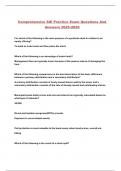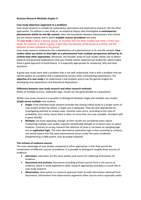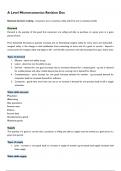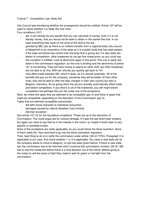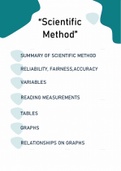DR.STEPHEN ODHIAMBO
NOTES
FINANCIAL MANAGEMENT
1. Introduction to financial management
Financial Management can be defined as the management of the finances of a business / organisation in
order to achieve financial objectives. Taking a commercial business as the most common organisational
structure, the key objectives of financial management would be to:
• Create wealth for the business
• Generate cash, and
• Provide an adequate return on investment bearing in mind the risks that the business is taking and the
resources invested. There are three key elements to the process financial management.
(a) Financial Planning
Management need to ensure that enough funding is available at the right time to meet the needs of the
business. In the short term, funding may be needed to invest in equipment and stocks, pay employees
and fund sales made on credit. In the medium and long term, funding may be required for significant
additions to the productive capacity of the business or to make acquisitions.
(b) Financial Control
Financial control is a critically important activity to help the business ensure that the business is meeting
its objectives. Financial control addresses questions such as:
• Are assets being used efficiently?
• Are the businesses assets secure?
• Do management act in the best interest of shareholders and in accordance with business rules?
(c) Financial Decision-making
The key aspects of financial decision-making relate to investment, financing and dividends:
• Investments must be financed in some way – however there are always financing alternatives that can
be considered. For example it is possible to raise finance from selling new shares, borrowing from banks
or taking credit from suppliers
• A key financing decision is whether profits earned by the business should be retained rather than
distributed to shareholders via dividends. If dividends are too high, the business may be starved of
funding to reinvest in growing revenues and profits further.
1
,2. The basic principles of financial management
There are ten principles that form the basics of FINANCIAL MANAGEMENT. These can be called as
the foundation of finance that plays significant role in decision making made by financial managers.
PRINCIPLE 1: The risk return trade off- investors would not take additional risk unless they expect to
be compensated with additional return.
PRINCIPLE 2: Time Value of Money - a dollar received today is worth more than a dollar received a
year from now.
PRINCIPLE 3: CASH, not profits is KING - it is cash flows not profits that are actually received by the
firm and can be reinvested.
PRINCIPLE 4: Incremental Cash Flows- It's only what changes that counts. The incremental cash flow
is the difference between the cash flows if the project is taken on versus what they will be if the project
is not taken on.
PRINCIPLE 5: The Curse of Competitive Markets-Why it's hard to find exceptionally profitable
projects.
PRINCIPLE 6: Efficient Capital Markets-the markets are quick and the prices are right. An efficient
market is characterized by a large number of profit-driven individuals who act independently.
PRINCIPLE 7: The Agency Problem-a problem resulting from conflicts of interest between the
manager/agent and the stockholder.
PRINCIPLE 8: Taxes Bias Business Decisions
PRINCIPLE 9: All Risk is not Equal-some risk can be diversified away, and some cannot.
PRINCIPLE 10: Ethical Behavior is doing the right thing, and ethical dilemmas are everywhere in
finance.
3. Introduction to working capital
The net working capital of a business is its current assets less its current liabilities
Current Assets include:
- Stocks of raw materials
- Work-in-progress
- Finished goods
- Trade debtors
- Prepayments
- Cash balances
2
,Current Liabilities include:
- Trade creditors
- Accruals
- Taxation payable
- Dividends payable
- Short term loans
Every business needs adequate liquid resources in order to maintain day-to-day cash flow. It needs
enough cash to pay wages and salaries as they fall due and to pay creditors if it is to keep its workforce
and ensure its supplies. Maintaining adequate working capital is not just important in the short-term.
Sufficient liquidity must be maintained in order to ensure the survival of the business in the long-term as
well. Even a profitable business may fail if it does not have adequate cash flow to meet its liabilities as
they fall due. Therefore, when businesses make investment decisions they must not only consider the
financial outlay involved with acquiring the new machine or the new building, etc, but must also take
account of the additional current assets that are usually involved with any expansion of activity.
Increased production tends to engender a need to hold additional stocks of raw materials and work in
progress. Increased sales usually mean that the level of debtors will increase. A general increase in the
firm’s scale of operations tends to imply a need for greater levels of cash.
4. Working Capital Needs of Different Businesses
Different industries have different optimum working capital profiles, reflecting their methods of doing
business and what they are selling.
• Businesses with a lot of cash sales and few credit sales should have minimal trade debtors.
Supermarkets are good examples of such businesses;
• Businesses that exist to trade in completed products will only have finished goods in stock. Compare
this with manufacturers who will also have to maintain stocks of raw materials and work-in-progress.
• Some finished goods, notably foodstuffs, have to be sold within a limited period because of their
perishable nature.
• Larger companies may be able to use their bargaining strength as customers to obtain more favourable,
extended credit terms from suppliers. By contrast, smaller companies, particularly those that have
recently started trading (and do not have a track record of credit worthiness) may be required to pay their
suppliers immediately.
• Some businesses will receive their monies at certain times of the year, although they may incur
expenses throughout the year at a fairly consistent level. This is often known as “seasonality” of cash
flow. For example, travel agents have peak sales in the weeks immediately following Christmas.
3
, Working capital needs also fluctuate during the year
The amount of funds tied up in working capital would not typically be a constant figure throughout the
year. Only in the most unusual of businesses would there be a constant need for working capital funding.
For most businesses there would be weekly fluctuations. Many businesses operate in industries that have
seasonal changes in demand. This means that sales, stocks, debtors, etc. would be at higher levels at
some predictable times of the year than at others. In principle, the working capital need can be separated
into two parts: • A fixed part, and • A fluctuating part
The fixed part is probably defined in amount as the minimum working capital requirement for the year.
It is widely advocated that the firm should be funded in the way shown in the diagram below:
The more permanent needs (fixed assets and the fixed element of working capital) should be financed
from fairly permanent sources (e.g. equity and loan stocks); the fluctuating element should be financed
from a short-term source (e.g. a bank overdraft), which can be drawn on and repaid easily and at short
notice.
5. Working Capital Cycle
As an introduction to the working capital cycle, here is a quick reminder of the main types of cash
inflow and outflow in a typical business:
Inflows Outflows
Cash sales to customers Purchasing finished goods for re-sale
4
NOTES
FINANCIAL MANAGEMENT
1. Introduction to financial management
Financial Management can be defined as the management of the finances of a business / organisation in
order to achieve financial objectives. Taking a commercial business as the most common organisational
structure, the key objectives of financial management would be to:
• Create wealth for the business
• Generate cash, and
• Provide an adequate return on investment bearing in mind the risks that the business is taking and the
resources invested. There are three key elements to the process financial management.
(a) Financial Planning
Management need to ensure that enough funding is available at the right time to meet the needs of the
business. In the short term, funding may be needed to invest in equipment and stocks, pay employees
and fund sales made on credit. In the medium and long term, funding may be required for significant
additions to the productive capacity of the business or to make acquisitions.
(b) Financial Control
Financial control is a critically important activity to help the business ensure that the business is meeting
its objectives. Financial control addresses questions such as:
• Are assets being used efficiently?
• Are the businesses assets secure?
• Do management act in the best interest of shareholders and in accordance with business rules?
(c) Financial Decision-making
The key aspects of financial decision-making relate to investment, financing and dividends:
• Investments must be financed in some way – however there are always financing alternatives that can
be considered. For example it is possible to raise finance from selling new shares, borrowing from banks
or taking credit from suppliers
• A key financing decision is whether profits earned by the business should be retained rather than
distributed to shareholders via dividends. If dividends are too high, the business may be starved of
funding to reinvest in growing revenues and profits further.
1
,2. The basic principles of financial management
There are ten principles that form the basics of FINANCIAL MANAGEMENT. These can be called as
the foundation of finance that plays significant role in decision making made by financial managers.
PRINCIPLE 1: The risk return trade off- investors would not take additional risk unless they expect to
be compensated with additional return.
PRINCIPLE 2: Time Value of Money - a dollar received today is worth more than a dollar received a
year from now.
PRINCIPLE 3: CASH, not profits is KING - it is cash flows not profits that are actually received by the
firm and can be reinvested.
PRINCIPLE 4: Incremental Cash Flows- It's only what changes that counts. The incremental cash flow
is the difference between the cash flows if the project is taken on versus what they will be if the project
is not taken on.
PRINCIPLE 5: The Curse of Competitive Markets-Why it's hard to find exceptionally profitable
projects.
PRINCIPLE 6: Efficient Capital Markets-the markets are quick and the prices are right. An efficient
market is characterized by a large number of profit-driven individuals who act independently.
PRINCIPLE 7: The Agency Problem-a problem resulting from conflicts of interest between the
manager/agent and the stockholder.
PRINCIPLE 8: Taxes Bias Business Decisions
PRINCIPLE 9: All Risk is not Equal-some risk can be diversified away, and some cannot.
PRINCIPLE 10: Ethical Behavior is doing the right thing, and ethical dilemmas are everywhere in
finance.
3. Introduction to working capital
The net working capital of a business is its current assets less its current liabilities
Current Assets include:
- Stocks of raw materials
- Work-in-progress
- Finished goods
- Trade debtors
- Prepayments
- Cash balances
2
,Current Liabilities include:
- Trade creditors
- Accruals
- Taxation payable
- Dividends payable
- Short term loans
Every business needs adequate liquid resources in order to maintain day-to-day cash flow. It needs
enough cash to pay wages and salaries as they fall due and to pay creditors if it is to keep its workforce
and ensure its supplies. Maintaining adequate working capital is not just important in the short-term.
Sufficient liquidity must be maintained in order to ensure the survival of the business in the long-term as
well. Even a profitable business may fail if it does not have adequate cash flow to meet its liabilities as
they fall due. Therefore, when businesses make investment decisions they must not only consider the
financial outlay involved with acquiring the new machine or the new building, etc, but must also take
account of the additional current assets that are usually involved with any expansion of activity.
Increased production tends to engender a need to hold additional stocks of raw materials and work in
progress. Increased sales usually mean that the level of debtors will increase. A general increase in the
firm’s scale of operations tends to imply a need for greater levels of cash.
4. Working Capital Needs of Different Businesses
Different industries have different optimum working capital profiles, reflecting their methods of doing
business and what they are selling.
• Businesses with a lot of cash sales and few credit sales should have minimal trade debtors.
Supermarkets are good examples of such businesses;
• Businesses that exist to trade in completed products will only have finished goods in stock. Compare
this with manufacturers who will also have to maintain stocks of raw materials and work-in-progress.
• Some finished goods, notably foodstuffs, have to be sold within a limited period because of their
perishable nature.
• Larger companies may be able to use their bargaining strength as customers to obtain more favourable,
extended credit terms from suppliers. By contrast, smaller companies, particularly those that have
recently started trading (and do not have a track record of credit worthiness) may be required to pay their
suppliers immediately.
• Some businesses will receive their monies at certain times of the year, although they may incur
expenses throughout the year at a fairly consistent level. This is often known as “seasonality” of cash
flow. For example, travel agents have peak sales in the weeks immediately following Christmas.
3
, Working capital needs also fluctuate during the year
The amount of funds tied up in working capital would not typically be a constant figure throughout the
year. Only in the most unusual of businesses would there be a constant need for working capital funding.
For most businesses there would be weekly fluctuations. Many businesses operate in industries that have
seasonal changes in demand. This means that sales, stocks, debtors, etc. would be at higher levels at
some predictable times of the year than at others. In principle, the working capital need can be separated
into two parts: • A fixed part, and • A fluctuating part
The fixed part is probably defined in amount as the minimum working capital requirement for the year.
It is widely advocated that the firm should be funded in the way shown in the diagram below:
The more permanent needs (fixed assets and the fixed element of working capital) should be financed
from fairly permanent sources (e.g. equity and loan stocks); the fluctuating element should be financed
from a short-term source (e.g. a bank overdraft), which can be drawn on and repaid easily and at short
notice.
5. Working Capital Cycle
As an introduction to the working capital cycle, here is a quick reminder of the main types of cash
inflow and outflow in a typical business:
Inflows Outflows
Cash sales to customers Purchasing finished goods for re-sale
4


